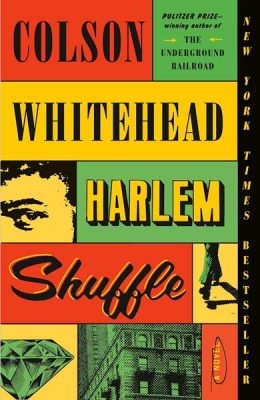Ray Carney Shakes Tail Feather Again in Colson Whitehead Novel
Review An assessment or critique of a service, product, or creative endeavor such as art, literature or a performance.
By Michael Malone
 “Harlem Shuffle” is the story of Ray Carney, who runs a furniture shop in Harlem, is a husband and father and mixes some shady business with the legit other half of his life.
“Harlem Shuffle” is the story of Ray Carney, who runs a furniture shop in Harlem, is a husband and father and mixes some shady business with the legit other half of his life.
Colson Whitehead wrote “Harlem Shuffle,” which was published in 2021, and authored another Ray Carney novel, “Crook Manifesto,” which came out last year.
“Harlem Shuffle” is set in three time frames: One entitled “The Truck” is 1959, “Dorvay” is 1961 and “Cool It Baby” is 1964.
“Crook Manifesto,” for its part, also is divided into three parts, showing Carney and his family in 1971, 1973 and 1976.
Ray Carney is someone you root for. A Harlem guy to the core, his mother died when he was 9, and his father was immersed in the crime life, often leaving his young son home alone for long stretches. Ray’s first experience with a firearm was borrowing one from his father’s closet when he was 13 to shoot rats behind their apartment.
His father pulled off jobs with a man named Pepper, who Ray turns to now and then when his sideline business needs muscle. Pepper is a tough guy of few words, and a fun character to follow. As a younger man, he faced a judge for beating yet another man unconscious, and is sent overseas to the war.
Other authors would be happy to have a wartime character simply dodging bullets, but Whitehead rethinks the motif for Pepper, who works on a crew that is carving out a supply line from India to China.
“It was one thing to believe the world was indifferent and cruel, and another to wake to proof every day in the treacherous mountain slopes, the hungry gorges and ravines, the myriad jungle treachery,” Whitehead writes. “Only a lazy God could deliver the meanness of things so unadorned.”
Ray always has his eye on a bigger and better apartment for his family, which includes his wife Elizabeth, a travel agent who specializes in safe places Black people can visit, and two young children. Their current apartment is tight, and has the roar and rumble of the subway passing by.
His in-laws have a place in Harlem’s prestigious Strivers’ Row, and Ray would not mind landing one there, too.
Ray is never good enough for his in-laws. They suspect he sells more than furniture out of his shop, and his skin color, darker than theirs, is an issue as well.
Carney’s Furniture does OK, but Ray balances his books with the freelance stuff –
fencing radios, jewelry and other valuables. He has a cousin named Freddie. When Ray’s father would disappear, he would live with Freddie and his mother. They are close, but dodgy Freddie makes it more and more difficult for Ray to stay on a straight path.
First Freddie is connected to a robbery of the Hotel Theresa, known as the Waldorf of Harlem. Then there’s the Van Wyck heist. He pulls his cousin into both imbroglios.
Freddie hangs around with a white junkie of considerable wealth. Linus is a Van Wyck, sharing his name with the expressway we take through Queens to get to JFK Airport, and his family is a real estate colossus. Linus and Freddie steal valuable family stuff.
Ray has a caper of his own as well. His in-laws suggest he try to get membership in a club for upscale Black men. A club official says a $500 check would help, so Ray writes the check – and is turned down.
He tries to get his money back, is denied and sets out for revenge.
The book jacket notes “the internal tussle between Ray the striver and Ray the crook,” and that’s the heart of both “Harlem Shuffle” and “Crook Manifesto.” Whitehead delivers a wholly engaging character trying to be legit, but finding it simply does not pay.
“Harlem Shuffle” offers a richly drawn portrait of the neighborhood in the 1960s, full of both hard workers and hustlers, all of them roiling after the killing of a Black teen by a police officer.
There’s also Whitehead’s fictional spin on real-life events, such as the World’s Fair in Queens in 1964 (where there’s a phone where you can see the person you’re speaking with!), and the World Trade Center slowly emerging in lower Manhattan.
Whitehead does a bit of research about 1960s furniture, and cranks out fun descriptions of a new piece or line for sale at Carney’s.
“Harlem Shuffle” has a 3.74 rating, out of 5, on GoodReads. It deserves better.
A review in The New York Times compared it to Whitehead’s “The Nickel Boys.” “Harlem Shuffle is a much calmer, shiftier and warmer book; a book that luxuriates in the seedy spaces of late night, ‘when the straight world slept and the bent got to work’; and that treats the realm of gangsters with names like Pepper, Chink Montague and Miami Joe as an extended, if dangerous, family.”
I would’ve liked to see more of Ray’s family life in “Harlem Shuffle,” including his wife. The book is dominated by male characters, be it Carney, Freddie, Pepper or another neighborhood oddball, Zippo.
Whitehead gives Zippo an enviable entrance: “Zippo arrived with his limp-dishrag posture, lanky and loose, the sleeves of his blue button-down shirt too short. Carney hadn’t seen him in years. He still rolled with that odd energy of his, defiant and jumpy, like a Bronx pigeon.”
If there’s a difference between a Bronx pigeon and a Harlem one, surely Whitehead knows.
Journalist Michael Malone lives in Hawthorne with his wife and two children.

Examiner Media – Keeping you informed with professionally-reported local news, features, and sports coverage.
